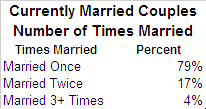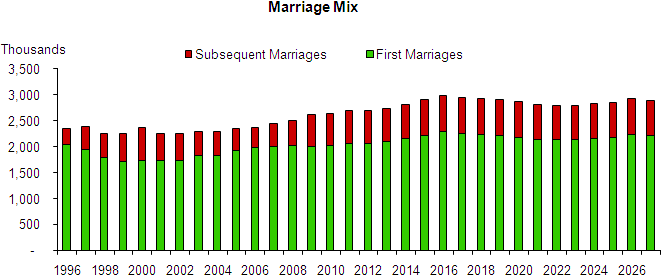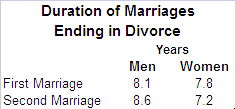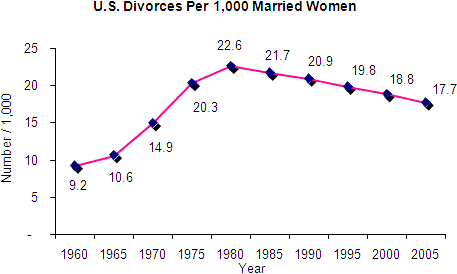IDEX Online Research: Challenges & Opportunities - Re-Marriages Help Fuel Demand for Bridal Jewelry
February 28, 08
Americans often marry more than once. Each time they marry, they typically purchase an engagement ring as well as other wedding-related jewelry. The mix in recent years between first weddings and subsequent weddings in a year is about three-fourths “first marriages” and one-fourth “second or more marriages.”
The table below summarizes data for 2004 (the latest data available) showing the percentage of married women and men who have been married once, twice, and three or more times.

Source: U.S. Census Bureau
The average price of a diamond engagement ring was about $3,210 in 2006. The average price point of a diamond engagement ring in second marriages is about 60 percent higher. It is a given that the second wife won’t accept a diamond engagement ring that is smaller than the one the husband gave his first wife.
In a recent survey by JCK Magazine, jewelers polled said that roughly 50 percent of their engagement sales came from first-time marriages, while about 28 percent came from second-time marriages. The balance of engagement ring sales came from subsequent marriages or same-woman, second-diamond sales.
Re-Marriages: An Important Market
In any given year, about 77 percent of all weddings are “first-time” brides, while the balance represents second and subsequent weddings. While subsequent marriages are often smaller affairs, jewelry is no less important. The second wife usually expects to get an engagement ring and wedding band that cost substantially more than that given to the first wife. Thus, this is an excellent sales opportunity for jewelers.
The graph below illustrates the actual and estimated marriage mix – the number of first-time marriages – compared to the number of subsequent marriages.

Source: U.S. Census Bureau, Center for Health Statistics
Re-Marriages: How Often?
The proverbial “seven-year itch” is real. There is an old adage about the “seven-year itch” which says that a couple is most likely to hit a rocky period in their marriage at about seven years. Based on the statistics, the “seven-year” adage is not far off the mark.
A study by the U.S. Census Bureau of couples who had been divorced, some multiple times, showed there is some truth to the “seven-year itch,” as the table below illustrates. Since it takes about a year to obtain a divorce in the U.S., it is safe to assume that most of these marriages ended after about seven years. Typically, both men and women wait about three and a half years before remarrying.
 Source: U.S. Census Bureau |
Thus, re-marriages can be an excellent opportunity for jewelers to develop a lifetime relationship with either the husband or the wife. When it comes to buying an engagement ring, jewelers with a pre-existing relationship with one of the spouses usually have a greater opportunity to supply the wedding jewelry. It is important to note that some discretion should be used by the jeweler; it isn’t appropriate to reference former spouses during the transaction.
What Is America’s Divorce Rate?
In 2005, there were just over 2.2 million marriages and just under 1.1 million divorces. That’s a divorce rate of about 50 percent, right?
Hold on, not so fast.
There has been much written in the popular press about America’s surging divorce rate. The problem is that the statistics are being misinterpreted. Here are the facts:
· Raw data suggests that the divorce rate in the U.S. is close to 50 percent. The problem is that the base year is one year of marriages (2.2 million in 2005, for example), but the divorces that occurred that year were from marriages over many years in the past (1.1 million divorces in 2005 from couples who married anytime over the past several decades). We believe that this comparison is not valid.
Of the 113 million households in the U.S. (2005 census data), there are 77 million “family” households, headed either by a couple, a man, or a woman. Of those family households, 58 million are headed by a couple. Thus, we believe the divorce rate should be calculated on the basis of this data: 1.1 million divorces out of 58 million “couples” households, or just under a 2 percent divorce rate annually.
The number of divorces per 1,000 married women, age 15 and older, has been declining since a peak in 1980, as the following graph illustrates.

Source: State Abstracts
· The background characteristics of people entering a marriage have major implications for their risk of divorce. Here are some percentage point decreases in the risk of divorce or separation during the first ten years of marriage, according to various personal and social factors. o Annual income over $50,000 (vs. under $25,000) -30%
o Having a baby after marriage vs. before marriage -24%
o Marrying over 25 years old (versus under 18) -24%
o Own family of origin intact (vs. divorced parents) -14%
o Religious affiliation (vs. none) -14%
o Some college (vs. high-school dropout) -13%
So, if you are a reasonably well-educated person with a decent income, come from an intact family and are religious, and marry after age 25 without having a baby first, your chances of divorce are very, very low.
A Declining Divorce Rate Is Not Good for Jewelers
While a declining divorce rate probably is a sign that Americans are taking marriage more seriously, it is not necessarily a good thing for jewelers. With fewer subsequent marriages, coupled with fewer really big-ticket diamond sales, jewelers will eventually feel the impact of a slowing divorce rate.
This article is part of a series that expands on the points IDEX Online’s director of online research, Ken Gassman, has raised in his analysis: “State of the Jewelry Industry.”
Ken is available to speak to corporate management groups and others about the State of the Jewelry Industry. He has developed a PowerPoint presentation which can be customized to your group. For further information, please email Ken at research[at]idexonline[dot]com.